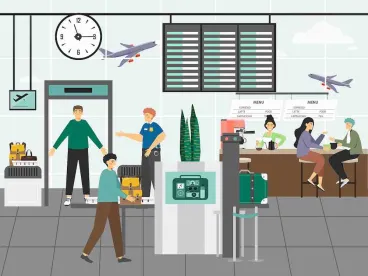In March 2022, the Transportation Security Administration (TSA) announced it would be implementing measures to conduct gender-neutral screening by enhancing screening technology, reducing the number of pat-downs needed, streamlining identity validation, updating TSA PreCheck, expanding airline partnerships to enhance the overall travel experience, and improving communications with the traveling public.
So far, TSA has implemented the following:
-
The TSA PreCheck application allows non-binary and gender non-conforming Americans to select gender based on self-attestation, regardless of sex assigned at birth. Those who are already PreCheck members may update gender data by calling the program at (855) 347-8371 weekdays between 8:00 a.m. and 10:00 p.m. EDT. It is not necessary to update gender on other identification documents so long as the name, known traveler number, and date of birth on the reservation matches the TSA record.
-
TSA is working with domestic air carriers to promote use and acceptance of the “X” gender marker. TSA recommends making reservations with the same gender marker that is on a traveler’s government-issued ID. If the marker on the traveler’s government-issued ID is not offered in the air carrier’s system, reach out to the air carrier. In 2016, Oregon was the first state to affirm the choice of nonbinary as a gender in the United States. Today, 22 states and the District of Columbia permit an “X” gender marker on a driver’s license. In addition, the “X” gender marker is available on U.S. passports.
-
Gender information is not considered when a traveler appears at the travel-document checker podium for identity verification, but the name shown on the identification documents should match the boarding pass.
-
All baggage must be screened. For carry-on baggage, individuals must inform the TSA officer if there are any medically necessary liquids, medications, medical equipment such as syringes or liquid medications, or prostheses. Those should be separated from other belongings before screening. If the bag must be opened, you may ask for it to be opened in private.
-
TSA is using Advanced Imaging Technology (AIT), a walk-through metal detector, or pat-down procedures. AIT still relies on gender-specific algorithms that only designate male or female and the officer will select the gender based on the officer’s assessment of how the individual presents. TSA is in the process of implementing a gender-neutral AIT algorithm. It is in the testing phase, and TSA anticipates implementing the new technology by the end of this year.
-
If there is an alarm during screening, additional screening, including a pat down, may be required. Pat downs are generally conducted by officers of the same sex as the traveler as determined by the officer, again, based on visual assessment. Individuals may inform the officer of their gender identity and request an officer of that gender. However, non-binary officers might not be available even upon request. Pat downs, like screening of baggage, can be done in the screening area or a private area may be requested.
-
As to communications, any individual who believes they have experienced an inappropriate screening process may ask to speak with a supervisor at the checkpoint and may also submit their concern to the TSA Contact Center.
Angie Cavallo also contributed to this article.





 />i
/>i

